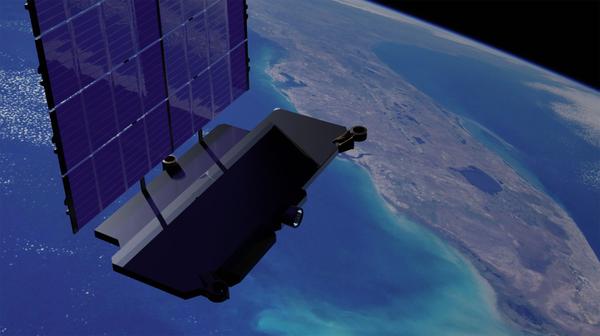SpaceX is taking a new approach to internet access, and it’s deploying a special vehicle to try it out.


The world is one step closer to having a totally secure internet and an answer to the growing threat of cyber-attacks, thanks to a team of international scientists who have created a unique prototype that could transform how we communicate online.
The invention led by the University of Bristol, revealed today in the journal Science Advances, has the potential to serve millions of users, is understood to be the largest-ever quantum network of its kind, and could be used to secure people’s online communication, particularly in these internet-led times accelerated by the COVID-19 pandemic.

Starlink Digital Illustration Created By: Erc X @ErcXspace via Twitter.
SpaceX is building its Starlink broadband internet satellite network in low Earth orbit. To date, the aerospace company has deployed 708 satellites out of the 4,409 that will initially make-up the network. Company officials state the main focus of the network will be to connect rural areas on Earth to the internet, areas where internet access is unreliable and inaccessible. Starlink customers will receive service from space via user terminals that look like a ‘UFO on a stick’. The wireless service will be easy to install at home, just ‘plug-in and point at sky.’
The company has not made public how much the internet service will cost per month. Regarding the pricing, SpaceX President Gwynne Shotwell told reporters last year – “All I know is you will be far happier with the value of the Starlink service than you are with your current service. You will, for sure, get way more bandwidth for the same price, or way more bandwidth for less…You’ll be far happier with this. The value will be far greater.” Starlink customers would be supporting missions to Mars; the revenue will provide additional funding towards the development of a Starship fleet that would enable humans to live on the Red Planet.

Featured Image Source: Merrillan, Wisconsin resident r/ darkpenguin22 via Reddit.
SpaceX is building its Starlink internet network in low Earth orbit. The aerospace company plans to fund its space program by offering affordable, low-latency, broadband internet globally. SpaceX initially plans to deploy 4,409 internet-beaming Starlink satellites, according to a recent letter the company sent to the Federal Communications Commission (FCC). These satellites will operate at altitudes between 550 to 570 kilometers above Earth. To date, there are approximately 708 Starlink satellites already in low Earth orbit.
Company employees are actively private beta testing the Starlink network via user terminals that look like a ‘UFO on a stick’ and Wi-Fi router. – “They show super-low latency and download speeds greater than 100 [megabits] per second [Mbps],” SpaceX Senior Engineer Kate Tice shared during the latest deployment broadcast, “That means our latency is low enough to play the fastest online video games and our download speeds are fast enough to stream multiple HD movies at once.”


Rolling out in most of its cities starting next year.
Google Fiber will double the maximum internet speed offered to its customers starting later this year from 1 Gbps to 2 Gbps, the company announced this week. The new plan will cost $100 a month, $30 more than the company’s existing 1 Gbps option. However, only downloads will be offered at the new maximum speed; uploads will remain at 1 Gbps. With the new plan, Google says it will provide customers with an unspecified “new Wi-Fi 6 router and mesh extender” to make the most of the new speeds.
Pilots of the new plan are due to kick off in Nashville, Tennessee, and Huntsville, Alabama, next month, with a full rollout in the two cities planned for later in the year. The company says it currently offers Google Fiber and Google Fiber Webpass (which uses over-the-air transmission rather than fiber optic cables) in 19 cities in the US. 2 Gbps pilots are due to start in its other markets later this year, with a rollout in “most” cities in early 2021.

The company disclosed the benchmarks in a presentation to the FCC.

With thousands of students using the internet to attend class remotely, cybersecurity experts are raising concerns about children becoming targets for hackers. Many Central New York school districts, like the Central Square Central School District, sent laptops home with students. Central Square uses a software called GoGuardian that flags unsafe or inappropriate online material. Superintendent Thomas Colabufo says parents are happy to know that the security feature is in place.

My latest publication in Satellite Markets and Research, with significant contribution of Ms. Zoe Shahid.
by Muhammad Furqan and Zoe Shahid
Brisbane, Australia, September 4, 2020 —Exponentially increasing numbers of announced ambitious NGSO (Non-Geo Stationary Orbit) or LEO-HTS (Lower Earth Orbit – High Throughput Satellites) Mega Constellations have been creating waves in the world of technology. Their success will not be a mere disruption to the existing system, it will be a whole new system altogether.
With regular revisions in numbers of satellites from existing players and entrance of new players, these mega constellations will redefine the dynamics of Space Race 2.0, Industry 4.0, 4th, and 5th Dimension Warfare. With the rollout of a complete extra-terrestrial network there will be multiple challenges faced by the new ecosystem. With multiple revisions of filings with FCC (Federal Communication Commission) OneWeb (Qualcomm, Virgin, Airbus) leads the race with 48,000 satellites followed StarLink of SpaceX with 42,000 and Project Kuiper of Amazon with 3300 (1st numbers, may revise with the trend of the competitors) odd and other multiple constellations of smaller numbers. Recently, Huawei also announced its arrival with China Unicom with numbers of satellites not yet publicly announced. Security Challenges.